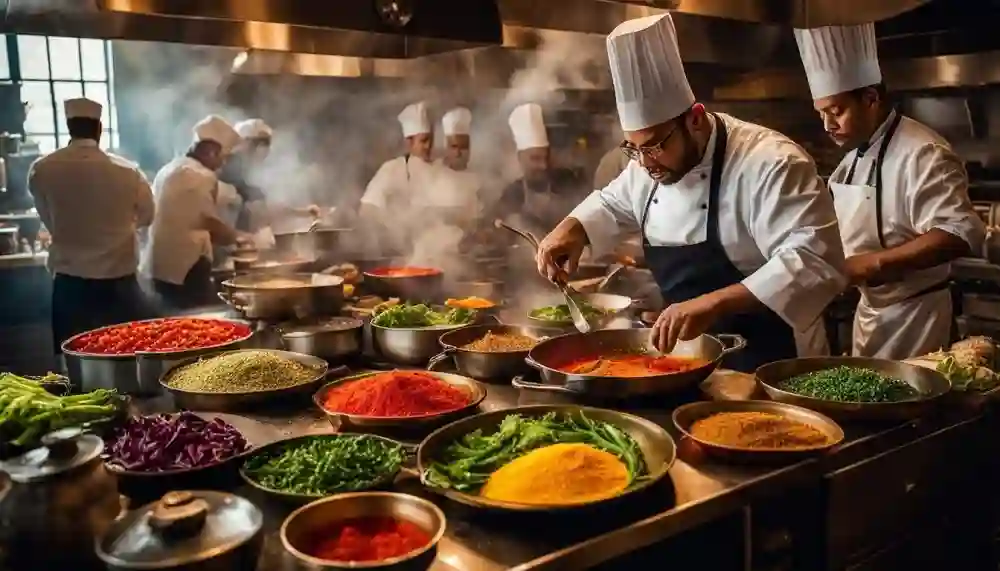Flavorful Recipes & Pro Cooking Tips for Culinary Enthusiasts

If you’re anything like me, flavorful recipes are your bread and butter. No matter how simple or complex, the ability to make a dish sing with the right flavors is a kitchen skill every culinary enthusiast dreams of. Personally, I’ve spent hours tinkering with recipes, trying to balance sweet, salty, sour, and bitter in perfect harmony. Sometimes I get it right, sometimes… well, not so much. But that’s the fun of it, right?
Here’s the thing: making food that wows isn’t just about following the instructions on the back of a jar. Sure, it’s easy to dump ingredients into a pot, but to really create something spectacular, it takes understanding the power of technique, timing, and ingredients. Trust me, I’ve learned this the hard way—especially after my disastrous attempt at a risotto that should have been creamy but ended up more like wallpaper paste. Don’t ask.
But enough about my cooking failures—let’s dive into how to actually do this.
Building Flavor: More Than Just Throwing Ingredients Together
One thing I’ve discovered through trial and error is that flavorful recipes don’t happen by accident. They’re about layering flavors, and understanding how ingredients can complement each other.
1. Fresh, High-Quality Ingredients Make All the Difference
We’ve all heard it before—fresh is best. But there’s a reason for it. I’ll never forget the first time I used fresh basil from my aunt’s garden (may it rest in peace—thank you, 2020 frost). The difference between supermarket basil and home-grown is like night and day. It wasn’t just about flavor, though; it was about the experience. It smelled like summer on a plate.
So, if you’re making a sauce or a salad and the recipe calls for fresh herbs—use them. Don’t cheat yourself with dried versions. Trust me on this one.
And when it comes to meat, don’t go cheap. That one time I bought “discount” chicken thighs, thinking I was saving money… yeah, let’s just say it tasted like regret. Local farms and higher-quality cuts might cost a bit more, but they pay off in the flavor department. Your taste buds will thank you.
2. Aromatics: The Unsung Heroes of Flavor
Aromatics—onions, garlic, shallots, ginger—these little powerhouses are what make a recipe go from “meh” to “wow.” I don’t care if you’re cooking a quick pasta dish or a slow-braised stew, these guys are your flavor soldiers.
My first real “aha” moment came when I learned how to slow-cook these aromatics. I used to just toss garlic in with everything at the end (rookie mistake). It wasn’t until I started gently sweating onions and garlic in olive oil that I realized how much richer the dish could be. The caramelization? I mean, come on. That deep, golden-brown flavor is the secret sauce of so many dishes.
3. Layering Your Seasoning: Don’t Just Dump Salt in at the End
I used to think adding salt was just a “finish it off” step—like, sprinkle it on top and call it a day. WRONG. Big mistake. Layering your seasoning throughout the cooking process is how you get that “depth of flavor” everyone talks about. Salt is an enhancer, not just an afterthought.
For instance, when I’m making a tomato sauce, I’ll add a pinch of salt to the onions while they cook down. This draws out moisture and helps them get all sweet and delicious. Then, I’ll add another sprinkle once the tomatoes go in. You get this balance that makes the dish taste like it’s been simmering for hours—even if you’re just getting started.
And then—wait—don’t forget to taste as you go. That’s a pro tip. A lot of recipes ask you to “season to taste,” and I used to be like, “What the heck does that mean?” But trust me, tasting and adjusting at every stage is the real key. Even a dash of balsamic vinegar in a stew can work wonders.
4. The Right Cooking Method Will Change Your Life
Cooking methods—where do I even begin? We all know that sautéing is great for quick flavor builds, but let me tell you about roasting. Oh man. Roasting vegetables is like magic. Seriously. The first time I threw sweet potatoes into the oven and let them roast at 400°F, they caramelized and transformed into the most luscious, sweet, and savory bite. I couldn’t even believe how much more flavor came out of those humble spuds.
Also, don’t get me started on grilling. Once I figured out that cooking over an open flame imparts this smoky, charred flavor, I’ve been grilling everything. My neighbors, Tina and Dave, laugh at me every summer because my grill is on so much it might as well be my new living room.
5. The Secret Weapon: Acidity
Alright, here’s the kicker: acid. Yeah, I know it sounds strange, but hear me out. Lemon juice. Vinegar. Lime zest. These little things work like magic to balance out a rich, fatty dish. I made a butter chicken once that was delicious, but it wasn’t until I added a squirt of lime juice at the very end that it became… phenomenal. That zip? It cut through the richness and brought everything together.
The acid helps wake up your taste buds. Trust me on this one—your chili needs a splash of vinegar, and your pasta sauce? A hint of lemon zest will take it to the next level.
Pro Cooking Tips You Can’t Miss
Okay, so you’ve got the basics. Now, here’s where I really start getting into the nitty-gritty. These are the pro tips that I swear by—some learned the hard way, and others that I’ve stolen from chefs who know their stuff.
1. Searing: Don’t Skip It
I cannot tell you how many steaks I ruined before I figured out the magic of searing. I used to think a steak was done once it hit a certain temperature. But no—first, you’ve got to sear that baby. Hot pan, hot oil, and leave it alone. Don’t mess with it. Just wait until it gets that nice, crispy crust.
This works for chicken, fish, pretty much anything. Seriously, do yourself a favor and don’t skip this step.
2. Meat Thermometer: Your Best Friend
Here’s a pro tip I learned from a very overcooked roast beef incident: Get a meat thermometer. I’ve ruined so many dinners thinking I could eyeball it, but having a thermometer in hand will take your stress level from 100 to a smooth zero. Plus, you won’t have to play the guessing game of whether your pork chop is undercooked or overdone.
Just stick the thermometer in, check, and—boom. Perfectly cooked meat every time.
3. Use Herbs & Spices Like a Pro
I used to be that person who thought “a sprinkle of garlic powder” was enough. Oh, how wrong I was. When you really start playing with fresh herbs and spices, that’s when things get interesting. Fresh rosemary, thyme, parsley—these herbs aren’t just for garnish. They’re flavor powerhouses.
A little bit of smoked paprika? Game-changer. And don’t even get me started on cumin—it’s like soul food in spice form. I’ve added it to everything from tacos to roasted carrots, and it never disappoints.
4. Rest Your Meat
Look, I get it. You’re hungry. You want to eat right away. But I swear by this—let your meat rest. I’ve ruined more steaks by slicing into them too soon. The juices haven’t had time to redistribute! Let it sit for 5-10 minutes and your meat will be so much juicier.
That’s the trick. It’s that simple. Patience is key.
5. Presentation Makes a Difference
I know, I know. Who cares about how it looks, right? But listen, plating matters. I learned this the hard way after serving what was honestly a delicious but sad-looking stew. A little fresh herb garnish here, a drizzle of sauce there—it’s not just for show. It elevates the experience.
Anyway, fast forward past three failed attempts at making “pretty food” and now I can actually pull it off. A good garnish? Totally worth it.
Wrapping Up: Flavorful Recipes Don’t Have to Be Hard
So there you have it. You don’t need to be a Michelin-star chef to make flavorful recipes—you just need a little patience, the right ingredients, and a willingness to experiment. And if things go wrong, well… that’s just part of the fun, right? I can’t tell you how many dishes I’ve totally bombed, but hey, it’s all about learning and improving.







